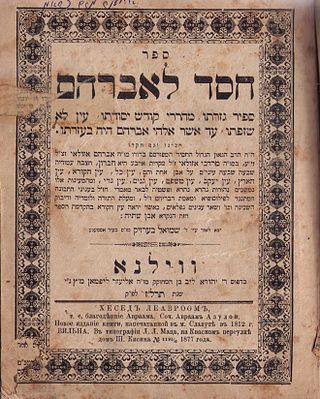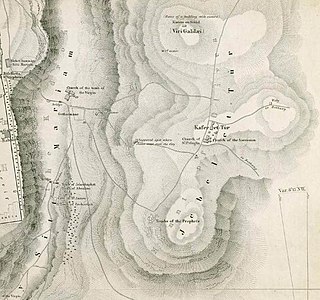Related Research Articles

Hebron is a Palestinian city in the southern West Bank, 30 kilometres (19 mi) south of Jerusalem. Hebron is capital of West Bank's largest governorate, known as Hebron Governorate. With a population of 201,063 in the city limits, the adjacent metropolitan area within the governorate is home to over 700,000 people. Hebron spans across an area of 74.102 square kilometres (28.611 sq mi). It is third largest city in the country, followed by Gaza and Jerusalem. The city is often considered one of the four holy cities in Judaism as well as in Islam and Christianity.
In Jewish law and history, Acharonim are the leading rabbis and poskim living from roughly the 16th century to the present, and more specifically since the writing of the Shulchan Aruch in 1563 CE.

Eliyahu de Vidas was a 16th-century rabbi in Ottoman Palestine. He was primarily a disciple of Rabbis Moses ben Jacob Cordovero and also Isaac Luria. De Vidas is known for his expertise in the Kabbalah. He wrote Reshit Chochmah, or "The Beginning of Wisdom," a pietistic work that is still widely studied by Orthodox Jews today. Just as his teacher Rabbi Moses Cordovero created an ethical work according to kabbalistic principles in his Tomer Devorah, Rabbi de Vidas created an even more expansive work on the spiritual life with his Reishit Chochmah. This magnum opus is largely based on the Zohar, but also reflects a wide range of traditional sources. The author lived in Safed and Hebron, and was one of a group of prominent kabbalists living in Hebron during the late 16th and early 17th-century.

Hebrew literature consists of ancient, medieval, and modern writings in the Hebrew language. It is one of the primary forms of Jewish literature, though there have been cases of literature written in Hebrew by non-Jews. Hebrew literature was produced in many different parts of the world throughout the medieval and modern eras, while contemporary Hebrew literature is largely Israeli literature. In 1966, Agnon won the Nobel Prize for Literature for novels and short stories that employ a unique blend of biblical, Talmudic and modern Hebrew, making him the first Hebrew writer to receive this award.

Palestinian Jews or Jewish Palestinians were the Jewish inhabitants of the Palestine region prior to the establishment of the State of Israel in 1948.

Abraham ben Mordecai Azulai was a Kabbalistic author and commentator born in Fez, Morocco. In 1599 he moved to Ottoman Palestine and settled in Hebron.
Samuel ben Hayyim Vital was a Kabalist born in Damascus in the latter half of the sixteenth century. While still young he married a daughter of Isaiah Pinto, rabbi of Damascus. Poverty compelled him to emigrate to Egypt, where, through the influence of prominent men, he was placed in charge of the cabalistic society Tiḳḳune ha-Teshubah. After a brief residence there he went to Safed, where he instructed the physician Jacob Zemah in Kabala. In the middle of the 17th century he returned to Egypt, where he died.
Aaron ben Moses Alfandari was a Talmudic writer born in Smyrna. He emigrated to the Land of Israel in his old age, where he met Chaim Yosef David Azulai, known as the CHIDA. In his book Shem HaGedolim, the CHIDA states he "got to meet the Rabbi in his old age in the holy city of Hebron, enjoying the radiance of his light..." Rabbi Alfandari was the first to sign the CHIDA's documents affirming him as an emissary to represent the Jewish community in foreign lands. The CHIDA lists him as one of the sages buried in the ancient Jewish cemetery in Hebron. Today, his name on the list is displayed on a plaque at the cemetery, although his exact grave site location was lost during the Jordanian period.
Alfandari was a family of eastern rabbis prominent in the 17th and 18th centuries, found in Smyrna, Constantinople, and Jerusalem. The name may be derived from a Spanish locality, perhaps from Alfambra. The following is a list of the chief members of the family:

Hayyim ben Jacob Abulafia was a rabbinical authority. He was the grandfather of Hayyim ben David Abulafia and grandson of Isaac Nissim aben Gamil. Abulafia was a rabbi in Smyrna, where he instituted many wholesome regulations. In his old age (1740) he restored the Jewish community in Tiberias.

Haim Palachi was a Jewish-Turkish chief rabbi of Smyrna (İzmir) and author in Ladino and Hebrew. His titles included Hakham Bashi and Gaon. He was the father of grand rabbis Abraham Palacci and Isaac Palacci and rabbi Joseph Palacci. He was a member of the Pallache family.
Rabbi Samuel ben Abraham Aboab also known by his acronym RaSHA was a 17th-century Western Sephardic rabbi and scholar, who is considered to be one of the greatest rabbinic sages of Italy. He served as the av bet din of Venice, where he rose to great prominence due to his vast knowledge of rabbinic literature. He is known for being an adamant opponent of the Sabbatean movement, and an early supporter of the old Yishuv.
Meir bar Hiyya Rofe was a Hebron rabbi, known among other things for his tours of Europe as an emissary from the Holy Land on behalf of the Jewish community of Hebron. His father, Hiyya Rofe, was a very learned rabbi from Safed. Orphaned at a young age, Meir studied in Hebron, leaving about 1648 as an emissary to Italy, Holland, and Germany. On his return journey, he stayed for two years in Italy to publish Ma'aseh Ḥiyya, his father's talmudic novellae and responsa. In Amsterdam he had influenced the wealthy Abraham Pereyra to found a yeshiva in Hebron to be called Hesed le-Avraham, of which Meir himself became the head scholar.
The history of Palestinian rabbis encompasses the Israelites from the Anshi Knesses HaGedola period up until modern times, but most significantly refers to the early Jewish sages who dwelled in the Holy Land and compiled the Mishna and its later commentary, the Jerusalem Talmud. During the Talmudic and later Geonim period, Palestinian rabbis exerted influence over Syria and Egypt, whilst the authorities in Babylonia had held sway over the Jews of Iraq and Iran. While the Jerusalem Talmud was not to become authoritative against the Babylonian Talmud, the liturgy developed by Palestinian rabbis was later destined to form the foundation of the minhag Ashkenaz that was used by nearly all Ashkenazi communities across Europe before Hasidic Judaism.
Nissim or Nisim may refer to:

Amram ben Diwan was a venerated 18th-century rabbi whose tomb has become the site of an annual pilgrimage.

The Jewish Cemetery on the Mount of Olives is the oldest and most important Jewish cemetery in Jerusalem. The Mount of Olives has been a traditional Hebrew/Jewish burial location since antiquity, and the main present-day cemetery portion is approximately five centuries old, having been first leased from the Jerusalem Islamic Waqf in the sixteenth century. The cemetery contains anywhere between 70,000 and 150,000 tombs, including the tombs of famous figures in early modern Jewish history. It is considered to be the largest and holiest historical Jewish cemetery on earth.
Zemah may refer to: